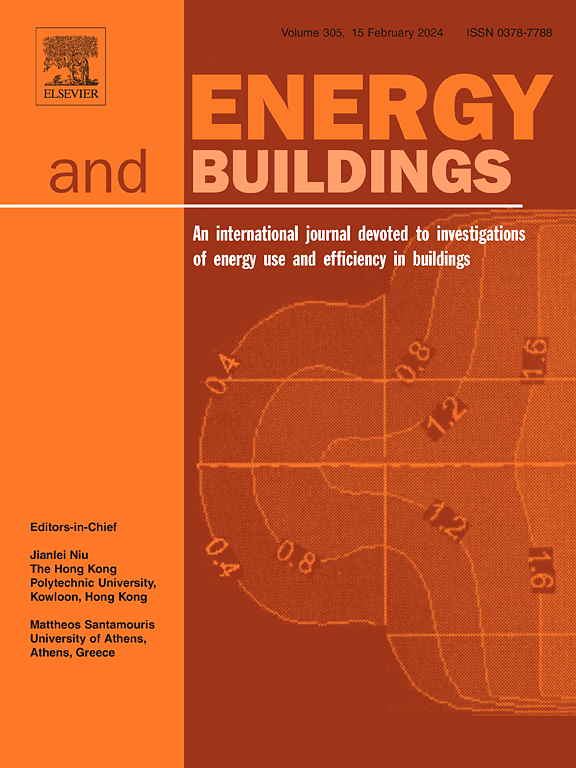Benchmarking Danish, Estonian and Finnish NZEB requirements with European Commission recommendations in residential and office buildings
IF 6.6
2区 工程技术
Q1 CONSTRUCTION & BUILDING TECHNOLOGY
引用次数: 0
Abstract
Comparing building energy performance across countries is challenging due to varying climatic conditions, calculation methods, primary energy (PE) factors, and input data discrepancies. This study systematically compares nearly zero-energy building (NZEB) requirements and energy calculation methodologies between Denmark, Finland, and Estonia, using a new office building, an apartment building, and a single-family house—each designed to comply with the respective national NZEB requirements. To account for climatic differences, a heating-degree-days correction factor was applied to thermal transmittance values of building envelope components. NZEB requirements of each country were then compared against the European Commission (EC) recommended values (EU 2016/1318) through normalization and benchmarking, employing detailed dynamic simulations. Both national and standardized (EN 16798–1:2019) input data was used with country-specific climate. In the benchmarking analysis, simulated primary energy performances were evaluated against EC NZEB thresholds, and the on-site renewable energy generation required to meet these targets was quantified. Results show that Estonian NZEB align with EC recommendations for Nordic climates, but EC Oceanic benchmarks were unmet even when Estonian configuration were applied to Danish climate indicating that the Oceanic benchmark is more ambitious than Nordic. Danish and Estonian national NZEB PE thresholds for office buildings showed a gap of 7% and 23%, respectively, to meet EC recommendations. However, the case study office building, surpassing Estonian NZEB standards, met both Nordic and Oceanic EC benchmarks. Finnish NZEB requirements were readily met by the case study buildings, highlighting that Finnish NZEB thresholds are currently less stringent compared to those of Denmark, Estonia, and the EC recommendations.
将丹麦、爱沙尼亚和芬兰的NZEB要求与欧盟委员会对住宅和办公楼的建议进行比较
由于不同的气候条件、计算方法、一次能源(PE)因素和输入数据差异,比较各国的建筑能源性能具有挑战性。本研究系统地比较了丹麦、芬兰和爱沙尼亚的近零能耗建筑(NZEB)要求和能源计算方法,使用了一栋新办公楼、一栋公寓楼和一栋独栋住宅,每一栋建筑的设计都符合各自国家的NZEB要求。为了考虑气候差异,对建筑围护结构构件的热透射率值应用了加热度-天校正因子。然后,通过标准化和基准测试,采用详细的动态模拟,将每个国家的NZEB要求与欧盟委员会(EC)推荐值(EU 2016/1318)进行比较。国家和标准化(EN 16798-1:2019)输入数据用于特定国家的气候。在基准分析中,模拟一次能源性能根据EC NZEB阈值进行评估,并对满足这些目标所需的现场可再生能源发电进行量化。结果表明,爱沙尼亚的NZEB符合欧委会对北欧气候的建议,但即使将爱沙尼亚的配置应用于丹麦气候,欧委会大洋洲的基准也没有达到,这表明大洋洲的基准比北欧的更雄心勃勃。丹麦和爱沙尼亚国家办公楼的NZEB PE阈值分别显示出7%和23%的差距,以满足欧共体的建议。然而,案例研究办公楼超越了爱沙尼亚的NZEB标准,满足了北欧和大洋洲的欧盟基准。芬兰的NZEB要求很容易被案例研究建筑所满足,突出表明芬兰的NZEB门槛目前与丹麦、爱沙尼亚和欧委会的建议相比不那么严格。
本文章由计算机程序翻译,如有差异,请以英文原文为准。
求助全文
约1分钟内获得全文
求助全文
来源期刊

Energy and Buildings
工程技术-工程:土木
CiteScore
12.70
自引率
11.90%
发文量
863
审稿时长
38 days
期刊介绍:
An international journal devoted to investigations of energy use and efficiency in buildings
Energy and Buildings is an international journal publishing articles with explicit links to energy use in buildings. The aim is to present new research results, and new proven practice aimed at reducing the energy needs of a building and improving indoor environment quality.
 求助内容:
求助内容: 应助结果提醒方式:
应助结果提醒方式:


